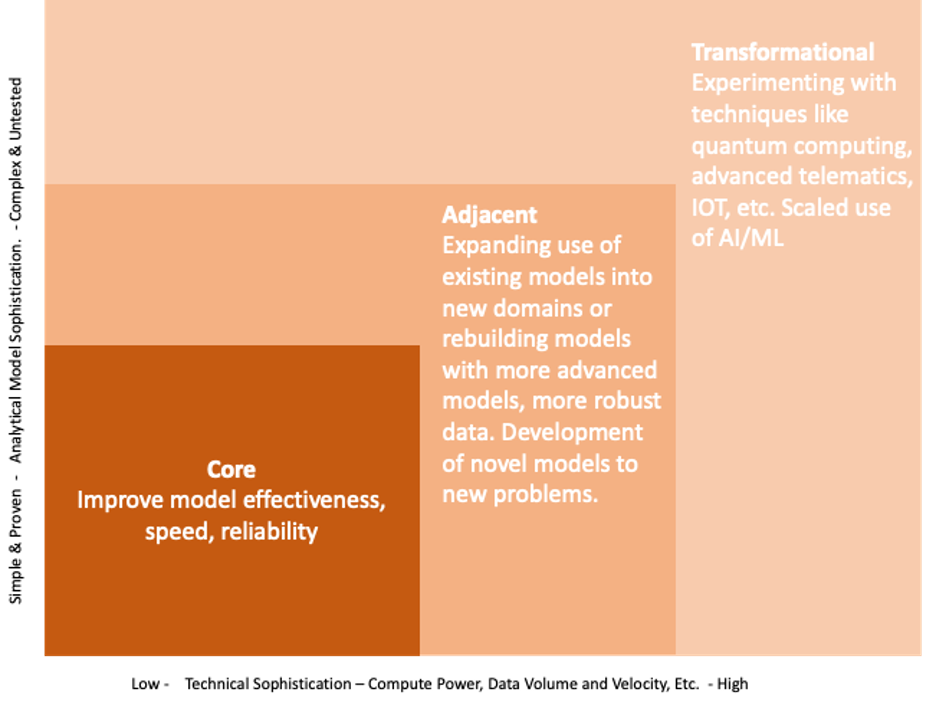
Warning, this blog contains a rant and rampant borrowing of innovation frameworks from publicly available sources. It’s a post about innovation that intentionally avoids creating something entirely new.
A Not So Random Rant
While there are many things that I love about the data and analytics profession there are a couple of things that frustrate me, a lot, and often. Analytics is a relatively new area in the business world and is filled with ambitious leaders. While these are a couple of reasons that it’s exciting, this combination often leads analytics professionals to attempt to invent new ways of driving business processes, like innovation. Additionally, like many senior leaders across functions, analytics folks can tend toward NIH syndrome – “not invented here.” Together these two less positive attributes of analytics can stymie our collective advancement. To counter this both in spirit and in practice I thought I’d share thoughts on how established, existing, tried-and-true innovation paradigms can be applied to an analytics program.
What is Innovation and Why Innovation Matters
In keeping with the simple is better, let’s say ‘innovation’ is a new way of doing something that creates more value. In this sense most analytics are relatively innovative in that, through the more sophisticated use of data, computing and mathematics, analytics can often find better solutions to business problems. Often times this means that analytics is incrementally innovative. And increasingly incremental innovation is not enough to deliver sustained competitive advantage. Truly innovative data savvy companies like Amazon do indeed deliver incremental analytics innovations, like better and faster search and recommendations, but one of Amazon’s biggest innovations (AWS) fits into adjacent or tangential innovation. They created a new business because of their data capability, a business that happens to also be extremely profitable and market leading.
We see that our clients’ interest in innovation continues to rise as evidenced by the strong interest in a presentation at our Symposium in 2019 by Alistair Croll (link is for registered clients). Outside of analytics, research has shown that a planned and disciplined approach to innovation leads to better financial performance. As observed in an HBR article, referenced below, “companies that allocated about 70% of their innovation activity to core (incremental) initiatives, 20% to adjacent ones, and 10% to transformational ones outperformed their peers, typically realizing a P/E premium of 10% to 20%.” Finally, from our research we see this multi-tiered, disciplined approach to analytics innovation drives improved analytics maturity.
Pick a framework, any framework
Since the key to driving analytics innovation is to be clear and deliberate when building out your analytics pipeline, it could be a good idea to use a framework you know well or one that’s used in your company. The key is that the framework drives discussions that help align your company around your ambitions and secure that you are reserving resources for things that are well beyond incremental innovation.
There are many innovation paradigms, guidelines, frameworks that you could leverage from academics, consultants and even commercial enterprises. Below are a few, and how they might be applied to analytics.
Three Horizons, from McKinsey. The horizons referenced are time horizons and adapting to analytics in your first horizon would be the improvement of known and effective analytics models, where the cost and time commitment are relatively small, but so are the gains. The second horizon would include analytics products which are brand new to your firm and likely very new to your industry, so their success is not guaranteed. Finally, the third is closer to a brave new world for you and your industry and would likely require significant time and resources and considerable risk. The key to this approach is that the starting point of the time horizon is the same – it’s now. The difference is when in time the analytics product might deliver value.
Software firm Thoughtworks has shared openly a four step model. The adaption to analytics in this framework is relatively straightforward, since it’s about digital business. What’s valuable about this framework is that it puts an emphasis on creating the capability to innovate in stages. It starts with building the base of learning and how to run experiments to create innovation, then advises that these new skills are first used to meet internal innovation needs. (In analytics, if all stakeholders are internal, you could focus on the most aligned business partner as a proxy for internal). It then moves onto external partners (where you could substitute the more challenging functions), then onto more ambitious attempts at bolder innovation. Although clearly a different approach than the Three Horizons, the key is that the approach is deliberate, helping you develop innovations that extend past incremental.
In an HBR piece from Monitor consultants (with some acknowledgment of the work of other thought leaders) there is a strong case for an innovation portfolio, where many concepts and effective visuals can be adapted to analytics like the one below, which I modified for analytics programs use.
From HBR - Managing Your Innovation Portfolio

From IIA - Managing Your Analytics Innovation Portfolio

Of course, what’s Adjacent to some analytics groups might be Transformational to others. And what goes in each box is open to debate. The key is not how precise or perfect the visual above is, what matters is that you lead your firm in a discussion about what fits into each box for your firm, and that you commit to ensuring that a noticeable amount of your work is in each box. It could be as little as 5% in Transformational if your industry is analytically immature. Both the discussion about the need for something there and the discipline to stick to your allocation matter above all else. Without some framework and discussion, it’s unlikely you will put any focus into more radical innovations for any material length of time.
“All models are wrong, some are useful”
This is just as true for a “model of models” in an innovation framework as it is for the models themselves. And it’s certainly true of what’s written by me above. Still, if you don’t actively build innovation into your analytics program, pretty soon your incremental gains will cease to be enough to ensure your analytics deliver value. And if your competition has built analytics innovation into their analytics program, that time will come sooner, rather than later.
Hungry for More
Some additional frameworks and resources you might consider include the Ten Types, which is a commercial product well explained in this blog. Another strong contribution via blog is Michael Andersson’s building on the portfolio approach. Or, for another more detailed view with a strong financial orientation consider the Eight Essentials from McKinsey.
About Drew
Drew has close to 20 years of experience, having worked on both the business side of analytics, leveraging insights for business performance, and on the delivery side of analytics driving the use of enterprise analytics. As the lead of Analytics Leadership Consortium, Drew drives engagement with analytics executives and top analytics practitioners in the IIA Community to help them lead their firm’s journey to analytics excellence.
Before joining the IIA, he led the Enterprise Data Analytics and Governance function at IKEA’s global headquarters in Europe. He leveraged analytics in various leadership roles across the IKEA value chain in both the United States and Europe. He received his MBA from Penn State and his undergraduate degree from Boston University.
About The Analytics Leadership Consortium (ALC)
The Analytics Leadership Consortium (ALC) is a closed network of analytics executives from diverse industries who meet to share and discuss real world best practices, as well as discover and develop analytics innovation, all for the purpose of improving the analytics maturity of their firms and securing the business impact they deliver.
You can view more posts by Drew here.
Follow IIA on LinkedIn, Twitter and Facebook for more updates.